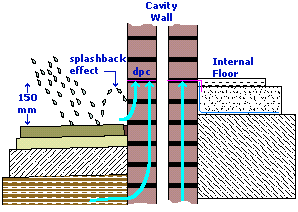Hello!
This is my first post here, I hope some of you gentlemen can help, I am living in a nightmare house, and I really don't want to get ripped off by dishonest damp proofers, if you can offer some help it will be much appreciated =)
I've taken some pictures to try to show clearly the problem.
There are isolated patches of damp in the house, both external and internal walls:
http://s113.photobucket.com/albums/n226/felixculpa81/?action=view¤t=dampcopy.jpg
The house was built in the late 30's and there IS an existing damp course, but a you can see from the image, they have put in a concrete path all around the house, which has brought the level of the DP to just 3cm off the ground! (I have read it should be at 15cm to be effective-?)
http://s113.photobucket.com/albums/n226/felixculpa81/?action=view¤t=3cm.jpg
Some people have said this existing DP failed due to age as well as being too low down.
But also...
There is a gutter drain which comes out directly onto the drive, instead of a drain, and a gap along the side of the house next to it:
http://s113.photobucket.com/albums/n226/felixculpa81/?action=view¤t=drain.jpg
Could it be that the water is pouring out the drain and going under the house, effectively leaving my house standing in a pool of water? Could simply moving the down-pipe be enough to solve the problem? Or do i need a new DPC as well?
(I should perhaps also point out that there is no heating in the house - if this makes a difference. And i live in rainy cold north of England!)
Any advice is really appreciated, as i do not want to pay (and also have the kitchen / bathroom apart) if it is not necessary. But now would be the best time for me if a DPC IS needed, as replastering is to be done as soon as possible, and the kitchen/bathroom are currently quite old.
It's a nightmare living here at the moment.
Thanks in advance.
This is my first post here, I hope some of you gentlemen can help, I am living in a nightmare house, and I really don't want to get ripped off by dishonest damp proofers, if you can offer some help it will be much appreciated =)
I've taken some pictures to try to show clearly the problem.
There are isolated patches of damp in the house, both external and internal walls:
http://s113.photobucket.com/albums/n226/felixculpa81/?action=view¤t=dampcopy.jpg
The house was built in the late 30's and there IS an existing damp course, but a you can see from the image, they have put in a concrete path all around the house, which has brought the level of the DP to just 3cm off the ground! (I have read it should be at 15cm to be effective-?)
http://s113.photobucket.com/albums/n226/felixculpa81/?action=view¤t=3cm.jpg
Some people have said this existing DP failed due to age as well as being too low down.
But also...
There is a gutter drain which comes out directly onto the drive, instead of a drain, and a gap along the side of the house next to it:
http://s113.photobucket.com/albums/n226/felixculpa81/?action=view¤t=drain.jpg
Could it be that the water is pouring out the drain and going under the house, effectively leaving my house standing in a pool of water? Could simply moving the down-pipe be enough to solve the problem? Or do i need a new DPC as well?
(I should perhaps also point out that there is no heating in the house - if this makes a difference. And i live in rainy cold north of England!)
Any advice is really appreciated, as i do not want to pay (and also have the kitchen / bathroom apart) if it is not necessary. But now would be the best time for me if a DPC IS needed, as replastering is to be done as soon as possible, and the kitchen/bathroom are currently quite old.
It's a nightmare living here at the moment.
Thanks in advance.



